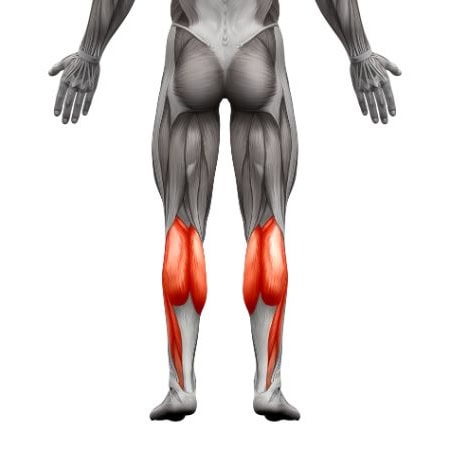Standing Calf Raises
How to do Standing Calf Raises?
Standing calf raises are a fundamental lower-body exercise that primarily targets the calf muscles, specifically the gastrocnemius and soleus. This movement involves lifting your heels off the ground to activate the calves, promoting strength, endurance, and muscle definition in the lower legs. This exercise can be done with body weight or added resistance (e.g., holding dumbbells or a resistance band), and you can use a wall or sturdy surface for balance.
Steps to Perform a Proper Standing Calf Raise:
1. Set Up in a Standing Position:
• Stand with your feet hip-width apart, toes pointing forward.
• Place one hand on a wall or other stable surface for balance if needed.
• Keep your body upright, shoulders back, and core engaged.
2. Position Your Feet for the Calf Raise:
• Place your feet flat on the ground, evenly distributing your weight.
• Shift slightly onto the balls of your feet, preparing to lift your heels.
3. Lift Your Heels Off the Ground:
• Exhale as you press through the balls of your feet, lifting your heels off the ground.
• Rise as high as possible onto the balls of your feet, focusing on engaging the calf muscles and keeping your knees straight but not locked.
4. Hold at the Top of the Movement:
• Pause for 1-2 seconds at the top of the movement, squeezing your calf muscles to maximize engagement.
5. Lower Your Heels Back to the Ground:
• Inhale as you slowly lower your heels back to the starting position, maintaining control to keep tension on the calves.
6. Repeat the Movement:
• Perform the desired number of repetitions, focusing on controlled movements and maintaining balance throughout.
Benefits of Standing Calf Raises
• Builds Calf Strength and Definition: This exercise effectively isolates the calf muscles, helping to develop strength and muscle tone.
• Improves Ankle Stability and Balance: Lifting onto the balls of your feet strengthens the ankle joint, promoting stability and balance in daily activities.
• Enhances Lower Leg Endurance: Calf raises build endurance in the calf muscles, supporting better performance in activities like walking, running, and jumping.
• Portable and Convenient: This exercise requires minimal equipment, making it ideal for home workouts or on-the-go training.
• Joint-Friendly: Bodyweight calf raises are gentle on the joints, making this exercise accessible for people with knee or ankle sensitivities.
• Supports Functional Strength: Strong calves support daily activities like climbing stairs and standing, enhancing lower body functionality.
• Accessible for All Fitness Levels: Calf raises can be easily adapted, making them suitable for beginners and advanced athletes alike.
Common Mistakes to Avoid
• Relying on Momentum: Avoid bouncing at the top or bottom; focus on a slow, controlled movement to fully engage the calf muscles.
• Leaning Forward or Backward: Keep your torso upright, engaging your core to prevent any leaning that could strain the lower back.
• Not Reaching Full Extension: Rise as high as possible onto the balls of your feet to maximize calf activation and range of motion.
• Locking the Knees: Keep your knees straight but avoid locking them, which can reduce calf engagement and strain the knee joints.
• Skipping the Eccentric Phase: Control the descent back to the ground rather than letting your heels drop quickly to maintain constant tension.
Tips for the proper execution of Standing Calf Raises
Engage the Core: Keep your core tight to stabilize your torso and maintain an upright posture.
Control the Movement: Avoid rushing through the reps; perform the exercise slowly to fully engage the calf muscles.
Squeeze at the Top: Hold at the top for a moment to maximize calf activation and time under tension.
Use Wall Support if Needed: Place one hand on a wall or other sturdy surface for balance if needed, especially if you’re new to the exercise.
Breathe Steadily: Exhale as you lift your heels, and inhale as you lower them, maintaining a steady rhythm.
Muscles worked when doing Standing Calf Raises
Primary Muscles:
•Gastrocnemius: The larger calf muscle, primarily responsible for lifting the heel and extending the foot.
•Soleus: The deeper calf muscle, engaged particularly when the knees are straight, supporting ankle stability and control.
Secondary Muscles:
•Anterior Tibialis: Assists in stabilizing the lower leg during the movement.
•Core: Engages to stabilize the torso and maintain balance.
•Feet Muscles: Support the lift and provide stability during the exercise.
Primary Muscle(s):
Secondary Muscle(s):
Equipment needed for Standing Calf Raises
No equipment needed for this exercise.
Adjust the difficulty of Standing Calf Raises
How to make Standing Calf Raises harder?
How to make Standing Calf Raises easier?
How to make Standing Calf Raises harder?
To make Standing Calf Raises harder:
-
Use a Single-Leg Variation: Perform the exercise on one leg at a time to increase the load on each calf, challenging balance and stability.
-
Add a Hold at the Top: Pause for 2-3 seconds at the top of each raise to increase time under tension and further engage the calf muscles.
-
Slow Down the Eccentric Phase: Take extra time lowering your heels to the ground, focusing on control and engaging the muscles during the eccentric (lengthening) phase.
-
Add Resistance: Hold dumbbells or a resistance band to increase the challenge, requiring more strength to lift against the added load.
How to make Standing Calf Raises easier?
To make Standing Calf Raises easier:
-
Perform Partial Raises: Lift only halfway to reduce intensity while still engaging the calf muscles.
-
Hold onto a Stable Support: Place both hands on a wall or stable surface to provide additional balance and reduce the focus on stability.
-
Perform Fewer Repetitions: Begin with a smaller number of reps (e.g., 8-10) and increase as you build calf strength.



